Ascending Saint Helens, Part 3 of 4: More than a mountain
I was almost five years old when I rode on my father’s back during a hike on Mt. Rainier one sunny Saturday afternoon. During that walk, he paused for a moment while viewing the distant, lofty, snow-capped peak to the southwest, speculating aloud on the possibility of one of the 18 volcanoes in the Cascade Mountain Range ever erupting. It was May 17th, 1980, and the next morning the world would forever be deprived of the last view my father had of Mt. Saint Helens.
With relatively little warning, an earthquake at 8:32 AM on Sunday, May 18th, 1980, caused the entire north face of Mt. Saint Helens to slide away. A thick column of ash rose high into the atmosphere and eventually came to rest in 11 different states, killing 57 people and thousands of animals and causing more than a billion dollars in damage.
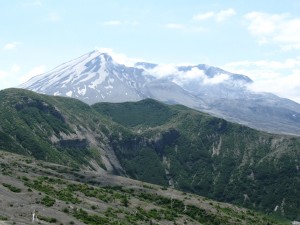 By then I was back home in Bothell, Washington, watching Sunday morning cartoons with my brother when an immense noise shook the house for several seconds. Moments later, my father came down the stairs and asked what the noise was. I told him I thought it was a “sonic boom,” the kind of noise made by jets from nearby military installations when they break the sound barrier. It wasn’t until we were on our way to church listening to the radio that we learned my father’s offhanded prediction the day before had come true. The once majestic Mt. Saint Helens had exploded, wreaking havoc upon many of Washington’s rivers, lakes and streams and in some towns, turning day into night within seconds.
By then I was back home in Bothell, Washington, watching Sunday morning cartoons with my brother when an immense noise shook the house for several seconds. Moments later, my father came down the stairs and asked what the noise was. I told him I thought it was a “sonic boom,” the kind of noise made by jets from nearby military installations when they break the sound barrier. It wasn’t until we were on our way to church listening to the radio that we learned my father’s offhanded prediction the day before had come true. The once majestic Mt. Saint Helens had exploded, wreaking havoc upon many of Washington’s rivers, lakes and streams and in some towns, turning day into night within seconds.
We watched the news reports from Spokane, Washington, where ash fell from the sky like snow during the pitch black lunch hour and plows were dispatched throughout the city to create traversable paths for anyone unlucky enough to be caught outside. Those who were caught outside covered their faces with dust masks, handkerchiefs and bandanas, and tried in vain to start cars whose air filters had been choked off with volcanic soot. KXLY’s Mike Fitzsimmons spent a record 56 hours on air reporting the Mt. Saint Helens eruption and its effects on eastern Washington. In short, it was a nightmare. Hell on Earth.
Bothell, on the other hand – along with most of the other communities closer to the mountain than Spokane – was spared the devastating ash fall thanks to the prevailing winds of the day blowing inland. It wasn’t until the area was reopened to civilians that I was able to survey the damage firsthand. Miles and miles of trees were stripped bare, painted grey and laid flat like combed hair. Entire lakes and rivers were completely relocated miles away and at higher elevations, and – perhaps most eerily – nothing stirred among the desolation. No birds, chipmunks or even insects made their presence known in the wasteland that remained of the Gifford Pinchot National Forest.
I’ve spent countless hours since that day visiting the area and watching its phoenix-like rebirth. The geological phenomenon that I lived through as a child had implanted itself deep within my curiosity and would forever hold a special place in my heart. For a (very) brief period in college I even switched my major to geology with the intention of becoming a volcanologist. However, after learning how much math was required to complete the degree, I instead chose communications as a future career path.
So there were any number of reasons why I chose in February 2012 to climb Mt. Saint Helens, some of them having nothing to do with the mountain itself. My father, for example, a longtime Washington resident, had spent an incalculable number of his weekends inside the confines of a lime-green 1970’s Apache pop-up camper with my mother, infant brother and me. Inviting him to climb the mountain with me was an appropriate way to say thank you for a sacrifice I would not understand until I had a family of my own. The date I chose, August 22nd, also happened to be two days after my 37th birthday and the anniversary of my paternal grandfather, Russ Ebel’s, birth. He served in the Army during World War II and spent a good deal of his later career in the United States Forest Service. He would have been 95 this year.
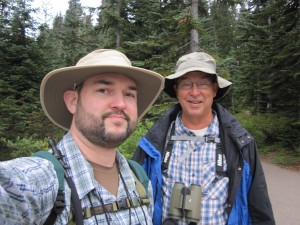 With the confidence of two novice mountain hikers setting off on an adventure steeped in meaning, Dad and I arrived at Climbers Bivouac at the foot of Mt. Saint Helens’ Monitor Ridge around 7:30 in the morning. Since it was estimated to take between 8 and 12 hours to complete the summit-and-back trip, we wanted to be sure to get an early start. There were perhaps two dozen other hikers preparing to set off on their journeys at the same time. With a brief prayer and a hint of nervous reluctance, Dad and I set off into the Gifford Pinchot National Forest prepared to meet any challenges we came across.
With the confidence of two novice mountain hikers setting off on an adventure steeped in meaning, Dad and I arrived at Climbers Bivouac at the foot of Mt. Saint Helens’ Monitor Ridge around 7:30 in the morning. Since it was estimated to take between 8 and 12 hours to complete the summit-and-back trip, we wanted to be sure to get an early start. There were perhaps two dozen other hikers preparing to set off on their journeys at the same time. With a brief prayer and a hint of nervous reluctance, Dad and I set off into the Gifford Pinchot National Forest prepared to meet any challenges we came across.
About 15 minutes into the winding forest trail, a lone buck darted across our path and began grazing not 30 feet from us. He would occasionally pause, looking at us from under two fuzzy spikes above his eyes. We interpreted his appearance to be a good sign for our journey.
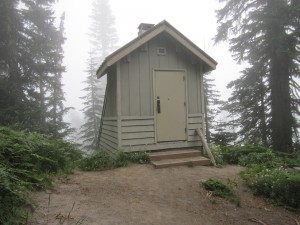 The morning fog hung low on the mountain’s south side as we made our way through the two miles of forest interrupted briefly by obscured rocky meadows and encounters with Clark’s Nutcrackers. Just before the forest gave way to wave after wave of rocky ridges and sandy valleys, we took the opportunity to use what we dubbed the “Sani-can in the Sky,” a self-composting pit toilet built above a steep ravine that represented the last manmade rest stop on the Monitor Ridge climbing route.
The morning fog hung low on the mountain’s south side as we made our way through the two miles of forest interrupted briefly by obscured rocky meadows and encounters with Clark’s Nutcrackers. Just before the forest gave way to wave after wave of rocky ridges and sandy valleys, we took the opportunity to use what we dubbed the “Sani-can in the Sky,” a self-composting pit toilet built above a steep ravine that represented the last manmade rest stop on the Monitor Ridge climbing route.
After breaking through the tree line, Dad and I followed the series of wooden posts stuck into the rock to mark the general concept of a trail but failing to reveal any actual well-trodden path. This is where we found our rock-hopping efforts at the Ocean Shores jetty come into play, though only in the ability to choose our footing strategically, two or three steps in advance like pawns in a game of chess. Had it been more realistic training, we would have been rock-hopping up a jetty at a 45-degree angle.
With every passing hour came another difficult scramble across a valley of boulders culminating in the ascent of a rocky ridge with the hopes of spotting the summit on the other side, only to be met with yet another, rockier valley and ridge extending off into the distance. We rested often and drank water continuously. It wasn’t hot at all, but we knew the fog would burn off at some point and our greatest enemy at that point was dehydration. Fortunately, we were able to avoid that condition altogether.
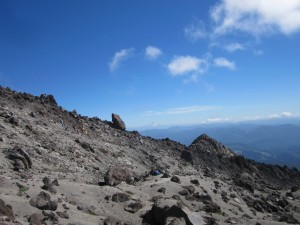 Eventually, as our time between rests grew shorter while our resting time grew longer, it became clear to me that Dad was having difficulty maintaining even a slow pace. About two-thirds of the way up the mountain, Dad finally succumbed to his aching legs and decided he was unable to continue. We shared a few moments looking at each other in silence, neither of us wanting to let the other down. Should we both turn around return only to try again on another day? Should I carry on alone while Dad waited for me or should he return to the car while I continued to the summit? We broke for lunch and eventually decided that I would continue my ascent while Dad would hold down the fort at what we dubbed “Camp Ebel,” a small domed rise on the valley floor crowned with boulders that resembled a picnic area.
Eventually, as our time between rests grew shorter while our resting time grew longer, it became clear to me that Dad was having difficulty maintaining even a slow pace. About two-thirds of the way up the mountain, Dad finally succumbed to his aching legs and decided he was unable to continue. We shared a few moments looking at each other in silence, neither of us wanting to let the other down. Should we both turn around return only to try again on another day? Should I carry on alone while Dad waited for me or should he return to the car while I continued to the summit? We broke for lunch and eventually decided that I would continue my ascent while Dad would hold down the fort at what we dubbed “Camp Ebel,” a small domed rise on the valley floor crowned with boulders that resembled a picnic area.
As I set off alone, I realized that there was a marked difference in my attitude. While I had been billowing with positive energy and excitement up to that point, not having Dad with me to share in the journey was more deflating than I had anticipated. Still, knowing that I had a good amount of endurance capability, I pressed on, reminded of what the effort was for and what it represented to both my father and me.
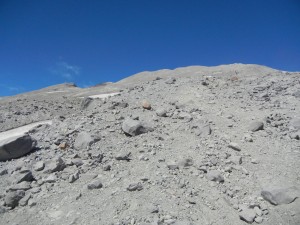 More ridges lined with razor-sharp pumice followed by valleys of igneous basalt covered in sand and gravel made the footing that much more unsteady, and I realized that the websites I’d read claiming this effort was tantamount to a “strenuous hike” were completely off their respective rockers. With my personal gas tank nearly on empty, I finally crested the last ridge before seeing the final path to the summit laid out before me. Someone had earlier described it to me as “300 yards of climbing a sand dune,” but it would have been more accurate to say a grueling half-mile of climbing through sand and rock, and blowing dust and ash with an oxygen supply reduced by 25% due to the altitude.
More ridges lined with razor-sharp pumice followed by valleys of igneous basalt covered in sand and gravel made the footing that much more unsteady, and I realized that the websites I’d read claiming this effort was tantamount to a “strenuous hike” were completely off their respective rockers. With my personal gas tank nearly on empty, I finally crested the last ridge before seeing the final path to the summit laid out before me. Someone had earlier described it to me as “300 yards of climbing a sand dune,” but it would have been more accurate to say a grueling half-mile of climbing through sand and rock, and blowing dust and ash with an oxygen supply reduced by 25% due to the altitude.
It took all I had to climb that last half-mile. I thought of Gifford Pinchot and John Muir, who had climbed St. Helens early last century when it still had an additional 1,400 feet, and Teddy Roosevelt, for whom much of the surrounding wilderness’ survival is attributed. I thought of my co-workers who had tried (and failed) in the months prior to my attempt, and the advice I had garnered from their experiences. I thought of my dad, and wanting to come down and tell him that I made it to the top. I thought of my grandfather and his lifetime of service to our country and our family. I thought of my wife and son (and coming daughter in November) and how much faith they had in me, knowing that I would summit the mountain I had my sights set upon. I passed a few other struggling climbers, offered them a few words of encouragement and continued steadily upward.
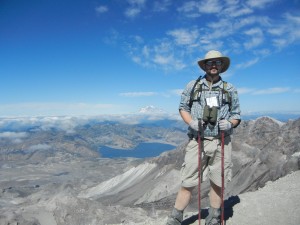 With a few final, purposeful steps my eyes broke the summit’s plane and I was finally privileged to view a sight that can hardly be expressed in words. Before me lay the clouds, far outstretched and whimsical, as if they themselves were simply happy to exist. In the distance, Mount Rainier, Mount Adams, Mount Hood, and Mount Jefferson could be seen clearly with the naked eye, while below me rested the curved lava dome in the center of the smoldering mile-wide crater.
With a few final, purposeful steps my eyes broke the summit’s plane and I was finally privileged to view a sight that can hardly be expressed in words. Before me lay the clouds, far outstretched and whimsical, as if they themselves were simply happy to exist. In the distance, Mount Rainier, Mount Adams, Mount Hood, and Mount Jefferson could be seen clearly with the naked eye, while below me rested the curved lava dome in the center of the smoldering mile-wide crater.
I fell to my knees and thanked God for allowing me to see this wondrous sight. I drank it in with all of my being, only pausing for a few moments after noticing a higher vantage point to my immediate left. I leapt to my feet and ran…yes, ran…up the sloping crater’s edge to my new viewpoint. I snapped pictures. I shot video. I sat in silence as, one by one, the other climbers began the return trip downward. I reveled in the fact that I had set this goal for myself and had accomplished it. I climbed Mount Saint Helens, an active stratovolcano in the state of my birth, responsible for one of history’s most decidedly unique geological events in which I was a participant at only four years old. I had found victory.
READ MORE…Ascending Saint Helens, Part 4 of 4: The gear that got me there
(Read Part 2 of 4: Rock-hopping at the jetty)

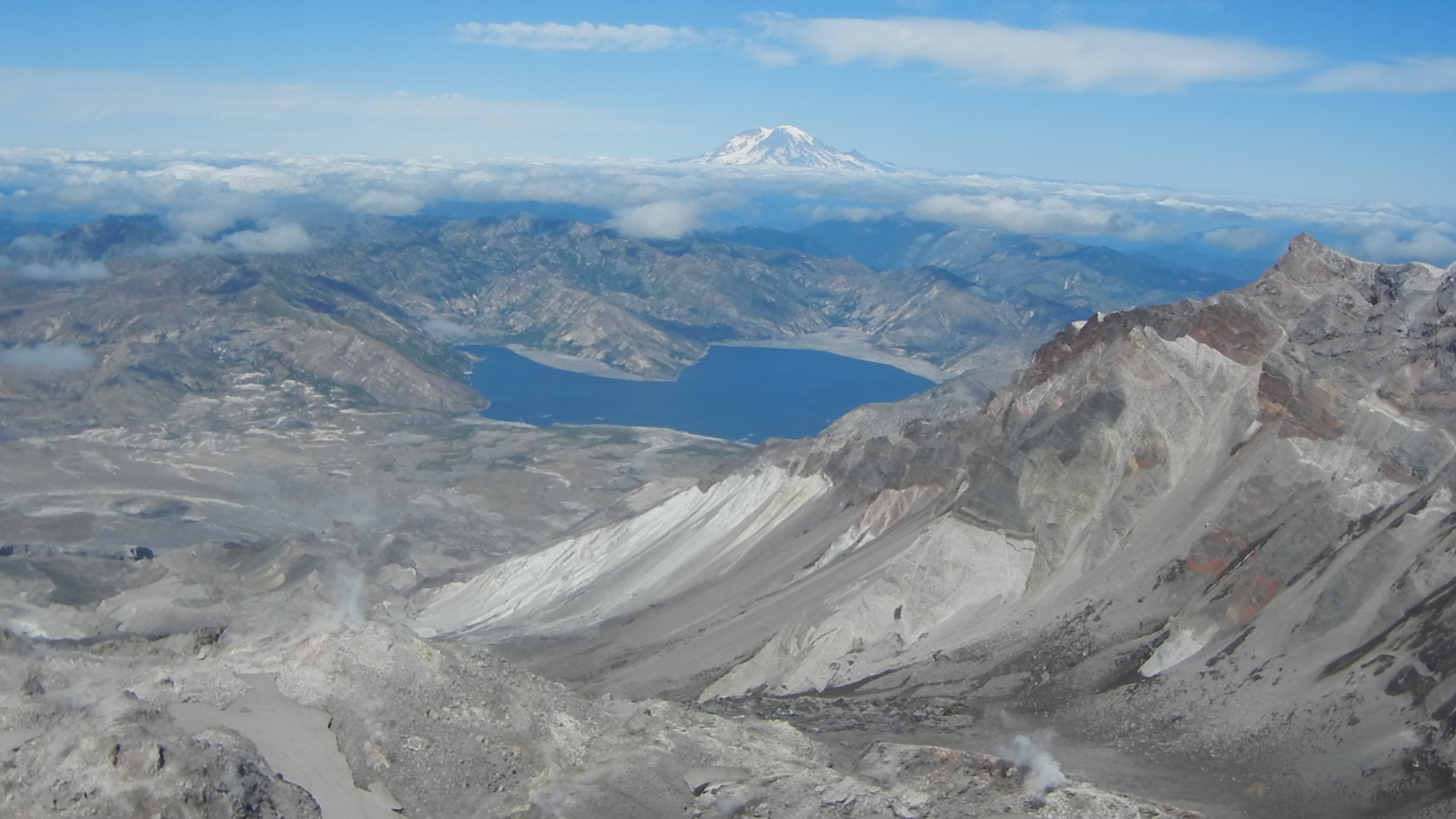

Pingback: Around the state in 48 hours: Part 1 | Washington, Our Home